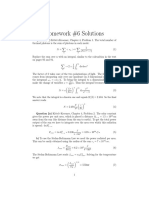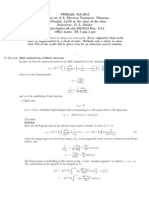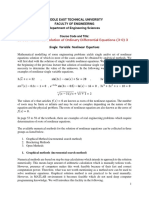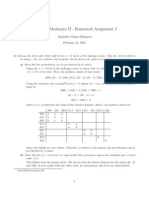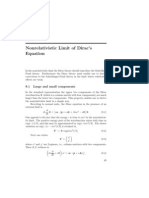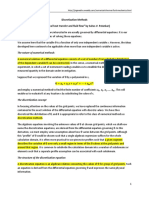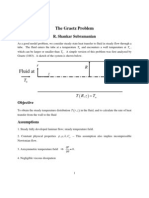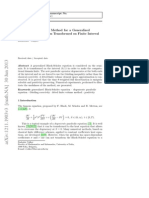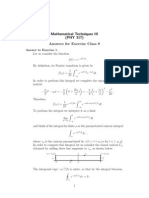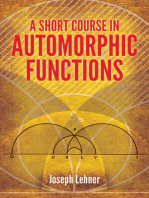Phase Transitions in Field Theories at Finite Temperatures: 1 Motivation
Uploaded by
chichieinsteinPhase Transitions in Field Theories at Finite Temperatures: 1 Motivation
Uploaded by
chichieinsteinPhase transitions in eld
theories at nite temperatures
Srivatsan
May 16, 2014
1 Motivation
In the usual textbook formulation of eld theory,
temperature is set to zero. In my presentation, I am
going to focus on the formalism to be adopted when
a temperature is turned on. This is especially im-
portant when one wishes to study phase transitions
in gauge theories. One reason why one should be in-
terested in this is the issue of baryon asymmetry. It
was pointed out in [1] that departure from thermal
equilibrium is required for a small baryon asymme-
try to be produced in the early universe. In the
Standard Model, the Baryon number violating tran-
sitions (which are primarily the result of instanton
tunneling) are exponentially supressed at zero tem-
perature. But in Electroweak Baryogenesis- they are
expected to occur frequently at temperatures com-
parable to or greater than the Electroweak transi-
tion temperature due to thermal activation. Thus
it is important to determine this temperature. It
had been observed in [3] that since the Coleman-
Weinberg eective potential is gauge dependent, the
critical tempertaure derived from this is similarly de-
pendent on gauge choice. I review a recent method
[4] to calculate the critical temperature in a gauge
independent way.
2 Matsubara formalism in the
static limit for scalars
I now start by reviewing the method of construct-
ing nite temperature partition functions in quan-
tum mechanics. This and the next section closely
follow [5]. The starting point is the denition of the
partition function
: = Tr[e
H
]
= 1/T
(1)
We can evaluate the trace using a path integral in
the x-representation and the result is given by Eq.
[2] with S
E
=
m
2
_
dx
d
_
2
+V (x())
The second equality follows from Feynmans path
integral formulation of Quantum Mechanics. The
minus sign and the absence of the imaginary unit
in the exponential can be understood from the fact
that instead of e
i
Ht
as the evolution operator,
we have e
H
. Thus the usual formulae of quan-
tum mechanics can be used with the identication
t i, L L
E
. We can now generalise this
argument to the case of a free scalar eld
: =
_
(0,x)=(,x)
x
T(, x)exp
_
S
E
_
where again
S
E
=
_
0
d
_
x
1
2
_
_
2
+
d
i=1
1
2
_
x
i
_
2
+V ()
The recipe for constructing the partition function for
scalar elds is thus that we restrict to elds which are
periodic in imaginary time. Thus, in the variable,
instead of a Fourier integral we have to deal with
Fourier series.
3 Fermions
For fermions, we need to introduce Grassman val-
ued elds in the path integral. Let a
and a be
the fermionic creation and annihilation operators re-
spectively. They anticommute. Consequently, the
Hilbert space has only two basis states [0 and [1.
If we introduce the Grassman numbers c and c
and
dene the states [c = e
c a
[0 then it is easy to see
for any operator
A we have
_
dc
dce
c
c
c[
A[c =
0[
A[0 +1[
A[1 = Tr[
A] The minus sign in the bra
1
: =
_
dxx[e
H
[x = C
_
x()=x(0)
Txe
S
E
(2)
is because the Grassman numbers anticommute with
the integration measure. Using this relation for the
operator e
H
, we get
: =
_
dc
dce
c
c
c[e
H
[c (3)
By the usual trick of insering complete states in be-
tween, we get the following result for the fermionic
partition function which is given in Eq. [4]
For Dirac elds, we again use the prescrip-
tion of going to imaginary time and changing the
sign of the Lagrangian. Thus, the Euclidean
version of the Dirac Lagrangian reads L
E
=
i
k
k
+m
4 Ghosts and Gauge elds
Gauge elds require special care since not all states
in the Hilbert space in a gauge theory are physical
and consequently the statistical hypothesis cannot
be applied to all of them. In this section, we fol-
low [6] and detail how the quantisation works in this
case. We start with the quantum Hamiltonian in the
A
a
0
= 0 gauge which is physical
H =
_
d
3
x
1
2
_
g
2
(E
a
)
2
+
1
g
2
(B
a
)
2
_
Inserting the complete set of states as usual, we
get for the amplitude A
[e
H
[A
_
TAexp
_
_
0
dt
_
d
3
x
1
2g
2
Tr
_
A
2
+B
2
_
_
where A(, x) = A
(x) and A(0, x) = A
(x)
Now, the trace of e
H
can be written as
a functional integral over periodic gauge elds.
But we must only include physical states in the
sum. The physical states satisfy D.E[
phys
=
0. This can be shown to be equivalent to re-
quire exp
_
i
_
d
3
xtr [D.E]
_
[
phys
= [
phys
for
all =
a
T
a
with compact support. This shows
that one should require the physical states to be
invariant under gauge transformations whose pa-
rameters vanish at innity. Such states can be se-
lected if one inserts the projection operator P =
_
()=0
Texp
_
i
_
d
3
xtr[D.E]
_
Thus the correct
partition function is given in Eq. [5] which exhibits
the partition function as an integral over elds which
are periodic upto a gauge transformation.
The strictly periodic condition can be obtained if
we redundantly insert the projector more than once
and we get the expression in Eq. [6]. Note that we
have renamed as A
0
in this equation.
The allowed gauge transformations are those that
vanish at innity and are periodic in . Moreover,
the Faddeev popov determinant is now dened over
periodic functions only. Thus when we carry out the
Faddeev popov quantisation, the ghosts are anticom-
muting, periodic functions in . This concludes our
survey of the various elds at nite temperature.
5 Interactions
Interactions are treated the same way as in zero tem-
perture eld theory. The derivation of Feynman
rules and other combinatoric factors is exactly the
same. The only dierence is that after Fourier de-
composition, the timelike parts of the momenta are
multiplies of the period in imaginary time. Hence
we sum over the timelike parts of the momenta in-
stead of integrating over them. Thus for example,
the propagator for a real scalar eld which at zero
temperature was
1
p
2
+m
2
can be written at nite tem-
perature as
G
0
(x y) = T
pn
e
ip(xy)
e
ipn
p
2
n
+E
2
p
2
: =
_
Tc
()Tc()exp
_
_
0
d
_
c
()
dc()
d
+H(c
(), c())
_
_
(4)
: = Tr(Pexp
H
) =
_
()=0
TTAA
U
[e
H
[A
=
_
()=0
T
_
A(,x)=A
U
(0,x)
TAexp
_
1
2g
2
_
_
0
dt
_
d
3
xTr
_
A
2
+B
2
_
__
(5)
: = lim
N
Tr(Pe
H
)
N
=
_
A(,x)=A(0,x)
TA
exp
_
1
4g
2
_
0
dt
_
d
3
xtr(F
)
_
(6)
6 Applications
6.1 Symmetry breaking transforma-
tions and the critical temperature
The critical temperature is dened as that temper-
ature above which the scalar condensate vanishes.
We now formalise this with the help of the Coleman-
Weinberg eective potential V (
2
). At zero temper-
ature, the theory is supposed to have a symmetry
breaking solution such that V
0
(
2
)/
a
= 0,
a
,=
0. At some nite temperature, if
V
(
2
)
a
,= 0,
a
,= 0
then symmetry is restored. We assume that V/
2
is positive for large
2
. Thus persistence of symme-
try requires V/
2
> 0 for ,= 0. Thus a necessary
condition for symmetry restoration is V (
2
)/
2
0 at = 0. Decomposing the eective potential into
its zero and positive temperature parts, we get the
result
V
c
2
=
m
2
2
where m is the renormalised
mass parameter and V
is the nite temperature
part of the eective potential. We now evaluate
the eective potential in the
4
theory. We use
Jackiws method [7] of shifting the elds by constant
(spacetime independent) elds and then reading o
the one loop correction from the propagator (which
now depends on the constant elds) and calculating
higher loops by evaluating vacuum diagrams using
the shifted lagrangian (now, the coupling constants
depend on the constant elds). The result for the la-
grangian / =
1
2
+
1
2
m
2
2
+
4
/4! is simply
V
1
(
2
0
) =
1
2
i
_
k
lnD
1
0
, k
=
1
2
n
_
k
ln
_
4
2
n
2
2
E
2
M
_
with E
2
M
= k
2
+m
2
+
1
2
2
0
and M
2
= m
2
+
1
2
2
The series can be summed and we nd V
1
(
2
0
) =
_
k
_
E
M
2
+
1
ln(1 e
E
M
)
_
. Thus, the total eec-
tive potential to one loop order is given by
V (
2
) =
1
64
2
_
M
4
ln
M
2
m
2
3
2
(M
2
2
3
m
2
)
2
_
+
1
2
2
4
_
0
x
2
ln(1 e
(x
2
+
2
M
2
)
)
where the temperature independent part has been
calculated in a problem set. The temperature depen-
dent part gives the location of the critical tempera-
ture. Note that naively setting the derivative with
respect to
2
equal to zero at
2
= 0 gives a result
for
C
that is complex. However we can obtain an
3
approximate value of the critical temperature if it is
large (for small
C
). We expand the eective poten-
tial in the limit of small and we get
1
2
C
= 24
m
2
.
Note that since we have assumed symmetry breaking
at zero temperature, m
2
< 0
6.2 Eective potential in gauge theo-
ries
This section follows [4]. Consider the Lagrangian
/ =
1
2
D
i
D
i
1
4
F
a
F
a
V ()
We can again shift each scalar eld
i
by a constant
i
=
i
+
i
and look at the quadratic part to get the
one loop eective action. This is a routine exercise
and we get in the R
gauge the quadratic part given
in Eq.[7] where M
2
ij
(
) =
2
V/
i
j
the derivative
being evaluated at
and m
2
A
(
)
ab
= g
2
(T
a
)
i
(T
b
)
i
while m
2
A
(
)
ij
= g
2
(T
a
)
i
(T
a
)
j
We now get the one loop potential which is given
in Eq.[8]
This at nite temperature gives Eq.[9]. In this
equation, m
2
i
(, ), m
2
a
() are the eigenvalues of
M
2
ij
()+m
2
()
ij
, m
2
A
()
ab
respectively. V
CW
is the
Coleman-Weinberg result at zero temperature and
J(z
2
) =
_
0
dxx
2
ln(1 e
x
2
+z
2
)
We see explicitly from Eq.[9] that in the eective
potential for gauge elds depends explicitly on the
gauge xing parameter . Thus the critical temper-
ature obtained from this potential is dependent on
gauge choice which is unphysical. the reason for this
conclusion is that as noted in [3], the eective po-
tential itself depends on gauge because the sourced
generating functional does not involve a conserved
source. The remedy for this and the correct method
to calculate the critical temperature is detailed in
the next subsection.
6.3 Gauge invariant calculation of
critical temperature
The starting point is the owing identity derived by
Nielsen [8] using BRST non-invariance of the gener-
ating functional. The identity reads
V
eff
= C
i
(, )
V
eff
i
(10)
This implies that the value of the eective potential
is gauge independent when it is stationary. But the
eld value that extremises it depends on the gauge
choice. Note that these identities are derived at zero
temperature. But since no non-trivial space-time or
energy-momentum integrations were involved in de-
riving them, these identities are also valid at non-
zero temperature.
Now we expand the eective potential in a loop
exansion
V
eff
(, T) = V
0
() + V
1
(, T) +
2
V
2
(, T) +
(11)
We want to solve
V
eff
min
= 0 (12)
We expand
min
itself as a series in
min
=
0
+
1
(T, ) +
2
2
(T, ) +
Here
0
denotes the tree level minimum. We then
expand Eq.[12] as
V
0
0+1+
2
2
+
V
1
0+1+
2
2
+ = 0
which is simply
V
0
0
+
_
V
1
0
+
1
2
V
0
0
_
+O
_
2
_
= 0
The result of this pertubative expansion is then sub-
stituted in Eq.[11] to get the following expansion
V
eff
(
min
(T), T) = V
0
(
0
) + V
1
(
0
, T)+
2
_
V
2
(
0
, T, )
1
2
2
1
(T, )
2
V
0
0
_
(13)
At each order, the expression for V
eff
is indepen-
dent of in Eq.[13]. To nd a critical temperature,
4
/
2
=
1
2
i
_
2
M
2
ij
(
) m
2
A
(
)
ij
j
+
1
2
A
a
_
(
2
g
(1
1
)
ab
+m
2
A
(
)
ab
g
_
A
b
a
_
ab
m
2
A
(
)
ab
b
(7)
V
eff
() = V
tree
()
i
2
_
d
d
p
(2)
d
_
Tr ln(p
2
M
2
ij
() m
2
A
()
ij
)
i
2
_
d
d
p
(2)
d
_
(d 1)Tr ln(p
2
m
2
A
()
ab
) + Tr ln(p
2
m
2
A
()) 2Tr ln(p
2
m
2
A
()
ab
)
(8)
V
eff
(, T) = V
tree
() +V
CW
() +
T
4
2
_
scalar
J
B
(m
2
i
(, )/T
2
) + 3
gauge,a
J
B
(m
2
a
()/T
2
)
gauge,a
J
B
(m
2
a
()/T
2
)
_
(9)
we simply nd each tree level minimum, substitute it
in the expansion above, and nd that temperature at
which the two lowest dierent branches cross. This
location gives a critical temperature. Note that this
whole process does not depend on at all.
References
[1] A.D. Sakharov, JETP Lett. 91B, 24 (1967)
[2] M. Trodden, Rev. Mod. Phys. 71 1463 (1999)
[3] L. Dolan and R.Jackiw, Phys. Rev. D 9 3320
(1974)
[4] H.H. Patel and M.J. Ramsey-Musolf, JHEP 7
(2011)
[5] M. Laine, Basics of Thermal Field Theory. A set
of online lecture notes from which parts of this
outline have been adopted.
[6] D.J. Gross, R.D. Pikarski, L.G. Yae, Rev. Mod.
Phys. 53, 1 (1981)
[7] R. Jackiw, Phys. Rev. D 9 1686 (1974)
[8] N.K. Nielsen, Nucl. Phys., B101, 173 (1975)
5
You might also like
- Thesis Marketing Strategies of Cadbury India LimitedNo ratings yetThesis Marketing Strategies of Cadbury India Limited83 pages
- PHZ6426: Fall 2013 Problem Set # 6: Electron Transport. Phonons. Due Monday, 12/02 at The Time of The Class Instructor: D. L. Maslov Maslov@phys - Ufl.edu 392-0513 Rm. 2114 Office Hours: TR 3 pm-4 PMNo ratings yetPHZ6426: Fall 2013 Problem Set # 6: Electron Transport. Phonons. Due Monday, 12/02 at The Time of The Class Instructor: D. L. Maslov Maslov@phys - Ufl.edu 392-0513 Rm. 2114 Office Hours: TR 3 pm-4 PM9 pages
- Resolvent Estimates For The Stokes Operator On An Infinite LayerNo ratings yetResolvent Estimates For The Stokes Operator On An Infinite Layer30 pages
- Numerical Solution of Ordinary Differential Equations Part 2 - Nonlinear EquationsNo ratings yetNumerical Solution of Ordinary Differential Equations Part 2 - Nonlinear Equations38 pages
- 5.74 Time-Dependent Quantum Mechanics: R, T I R, TNo ratings yet5.74 Time-Dependent Quantum Mechanics: R, T I R, T12 pages
- Nonrelativistic Limit of Dirac's Equation: 8.1 Large and Small ComponentsNo ratings yetNonrelativistic Limit of Dirac's Equation: 8.1 Large and Small Components4 pages
- Lecture 18: Scattering: Partial Wave Analysis (11/22/2005) : Classical Scattering: Impact ParameterNo ratings yetLecture 18: Scattering: Partial Wave Analysis (11/22/2005) : Classical Scattering: Impact Parameter8 pages
- Discretization Methods ("Numerical Heat Transfer and Fluid Flow" by Suhas V. Patankar)No ratings yetDiscretization Methods ("Numerical Heat Transfer and Fluid Flow" by Suhas V. Patankar)4 pages
- Discretization Methods ("Numerical Heat Transfer and Fluid Flow" by Suhas V. Patankar)No ratings yetDiscretization Methods ("Numerical Heat Transfer and Fluid Flow" by Suhas V. Patankar)4 pages
- From Fourier Series To Fourier Integral: e X E, e eNo ratings yetFrom Fourier Series To Fourier Integral: e X E, e e10 pages
- 4 Quantization of The Photon Field: 4.1 Maxwell Equations and Gauge InvarianceNo ratings yet4 Quantization of The Photon Field: 4.1 Maxwell Equations and Gauge Invariance7 pages
- Fitted Finite Volume Method For A Generalized Black-Scholes Equation Transformed On Finite IntervalNo ratings yetFitted Finite Volume Method For A Generalized Black-Scholes Equation Transformed On Finite Interval22 pages
- Minkowski-Space Correlators in Ads/Cft Correspondence: Recipe and ApplicationsNo ratings yetMinkowski-Space Correlators in Ads/Cft Correspondence: Recipe and Applications28 pages
- ***(half-space?)GLOBAL HEAT KERNEL ESTIMATESNo ratings yet***(half-space?)GLOBAL HEAT KERNEL ESTIMATES22 pages
- Mathematical Techniques III (PHY 317) Answers For Exercise Class 8No ratings yetMathematical Techniques III (PHY 317) Answers For Exercise Class 85 pages
- Gauge Invariance in Classical ElectrodynamicsNo ratings yetGauge Invariance in Classical Electrodynamics22 pages
- Heaviside Operational Calculus by J R CarsonNo ratings yetHeaviside Operational Calculus by J R Carson26 pages
- Rodrigues & Vaz - Subluminal and Superluminal Slution in Vacuum of Maxwell Equations and Massless Dirac Equation 1995No ratings yetRodrigues & Vaz - Subluminal and Superluminal Slution in Vacuum of Maxwell Equations and Massless Dirac Equation 19958 pages
- Finite Difference Solution of The Heat Equation: Adam PowellNo ratings yetFinite Difference Solution of The Heat Equation: Adam Powell6 pages
- A Exam Presentation: Instantons and The U (1) Problem: Christian SpethmannNo ratings yetA Exam Presentation: Instantons and The U (1) Problem: Christian Spethmann44 pages
- Xequivalence Between Schrödinger and Feynman Formalisms For Quantum Mechanics The Path Integral FormulationNo ratings yetXequivalence Between Schrödinger and Feynman Formalisms For Quantum Mechanics The Path Integral Formulation14 pages
- Melnikov's Method As Applied To The Double PendulumNo ratings yetMelnikov's Method As Applied To The Double Pendulum18 pages
- Differential Forms in Algebraic TopologyNo ratings yetDifferential Forms in Algebraic Topology171 pages
- Research Progress: 1 Lorentz TransformationsNo ratings yetResearch Progress: 1 Lorentz Transformations9 pages
- Mto Structure and Foundation CondensateNo ratings yetMto Structure and Foundation Condensate39 pages
- 1.0 Overview of Operating System DeploymentNo ratings yet1.0 Overview of Operating System Deployment7 pages
- Bethke, Bruce & Day, Vox - Rebel Moon (1416501908) PDFNo ratings yetBethke, Bruce & Day, Vox - Rebel Moon (1416501908) PDF147 pages
- 03 11 2024 - SR - Super60 - NUCLEUS&STERLING BT - Jee Adv (2020 P2) - CTA 08&15 - Q.PaperNo ratings yet03 11 2024 - SR - Super60 - NUCLEUS&STERLING BT - Jee Adv (2020 P2) - CTA 08&15 - Q.Paper20 pages
- 3.4. Estimation of Evaporation: A Mmhg. Evaporation ENo ratings yet3.4. Estimation of Evaporation: A Mmhg. Evaporation E7 pages
- U of H Open Records Complaint To Texas Attorney GeneralNo ratings yetU of H Open Records Complaint To Texas Attorney General21 pages
- Review of "An Economic Analysis of A Drug-Selling Gang's Finances" by Steven D. Levitt and Sudhir Alladi VenkateshNo ratings yetReview of "An Economic Analysis of A Drug-Selling Gang's Finances" by Steven D. Levitt and Sudhir Alladi Venkatesh2 pages
- Cisco Aironet 3800 Series Access Points Getting Started GuideNo ratings yetCisco Aironet 3800 Series Access Points Getting Started Guide46 pages
- Idiomatic Rust - Matthias Endler - FOSDEM 2018No ratings yetIdiomatic Rust - Matthias Endler - FOSDEM 201843 pages
- Atashi No Onii-Chan Dekita! Onii-Chan7313No ratings yetAtashi No Onii-Chan Dekita! Onii-Chan73131 page
- Thesis Marketing Strategies of Cadbury India LimitedThesis Marketing Strategies of Cadbury India Limited
- PHZ6426: Fall 2013 Problem Set # 6: Electron Transport. Phonons. Due Monday, 12/02 at The Time of The Class Instructor: D. L. Maslov Maslov@phys - Ufl.edu 392-0513 Rm. 2114 Office Hours: TR 3 pm-4 PMPHZ6426: Fall 2013 Problem Set # 6: Electron Transport. Phonons. Due Monday, 12/02 at The Time of The Class Instructor: D. L. Maslov Maslov@phys - Ufl.edu 392-0513 Rm. 2114 Office Hours: TR 3 pm-4 PM
- Resolvent Estimates For The Stokes Operator On An Infinite LayerResolvent Estimates For The Stokes Operator On An Infinite Layer
- Numerical Solution of Ordinary Differential Equations Part 2 - Nonlinear EquationsNumerical Solution of Ordinary Differential Equations Part 2 - Nonlinear Equations
- 5.74 Time-Dependent Quantum Mechanics: R, T I R, T5.74 Time-Dependent Quantum Mechanics: R, T I R, T
- Nonrelativistic Limit of Dirac's Equation: 8.1 Large and Small ComponentsNonrelativistic Limit of Dirac's Equation: 8.1 Large and Small Components
- Lecture 18: Scattering: Partial Wave Analysis (11/22/2005) : Classical Scattering: Impact ParameterLecture 18: Scattering: Partial Wave Analysis (11/22/2005) : Classical Scattering: Impact Parameter
- Discretization Methods ("Numerical Heat Transfer and Fluid Flow" by Suhas V. Patankar)Discretization Methods ("Numerical Heat Transfer and Fluid Flow" by Suhas V. Patankar)
- Discretization Methods ("Numerical Heat Transfer and Fluid Flow" by Suhas V. Patankar)Discretization Methods ("Numerical Heat Transfer and Fluid Flow" by Suhas V. Patankar)
- From Fourier Series To Fourier Integral: e X E, e eFrom Fourier Series To Fourier Integral: e X E, e e
- 4 Quantization of The Photon Field: 4.1 Maxwell Equations and Gauge Invariance4 Quantization of The Photon Field: 4.1 Maxwell Equations and Gauge Invariance
- Fitted Finite Volume Method For A Generalized Black-Scholes Equation Transformed On Finite IntervalFitted Finite Volume Method For A Generalized Black-Scholes Equation Transformed On Finite Interval
- Minkowski-Space Correlators in Ads/Cft Correspondence: Recipe and ApplicationsMinkowski-Space Correlators in Ads/Cft Correspondence: Recipe and Applications
- Mathematical Techniques III (PHY 317) Answers For Exercise Class 8Mathematical Techniques III (PHY 317) Answers For Exercise Class 8
- Rodrigues & Vaz - Subluminal and Superluminal Slution in Vacuum of Maxwell Equations and Massless Dirac Equation 1995Rodrigues & Vaz - Subluminal and Superluminal Slution in Vacuum of Maxwell Equations and Massless Dirac Equation 1995
- Finite Difference Solution of The Heat Equation: Adam PowellFinite Difference Solution of The Heat Equation: Adam Powell
- A Exam Presentation: Instantons and The U (1) Problem: Christian SpethmannA Exam Presentation: Instantons and The U (1) Problem: Christian Spethmann
- Xequivalence Between Schrödinger and Feynman Formalisms For Quantum Mechanics The Path Integral FormulationXequivalence Between Schrödinger and Feynman Formalisms For Quantum Mechanics The Path Integral Formulation
- Melnikov's Method As Applied To The Double PendulumMelnikov's Method As Applied To The Double Pendulum
- Bethke, Bruce & Day, Vox - Rebel Moon (1416501908) PDFBethke, Bruce & Day, Vox - Rebel Moon (1416501908) PDF
- 03 11 2024 - SR - Super60 - NUCLEUS&STERLING BT - Jee Adv (2020 P2) - CTA 08&15 - Q.Paper03 11 2024 - SR - Super60 - NUCLEUS&STERLING BT - Jee Adv (2020 P2) - CTA 08&15 - Q.Paper
- 3.4. Estimation of Evaporation: A Mmhg. Evaporation E3.4. Estimation of Evaporation: A Mmhg. Evaporation E
- U of H Open Records Complaint To Texas Attorney GeneralU of H Open Records Complaint To Texas Attorney General
- Review of "An Economic Analysis of A Drug-Selling Gang's Finances" by Steven D. Levitt and Sudhir Alladi VenkateshReview of "An Economic Analysis of A Drug-Selling Gang's Finances" by Steven D. Levitt and Sudhir Alladi Venkatesh
- Cisco Aironet 3800 Series Access Points Getting Started GuideCisco Aironet 3800 Series Access Points Getting Started Guide





